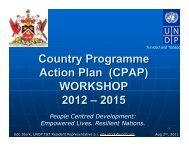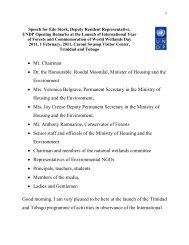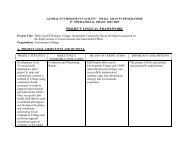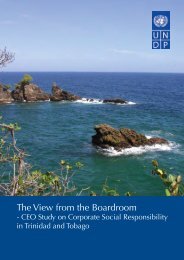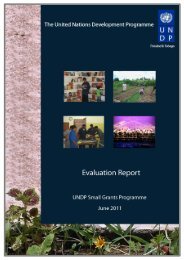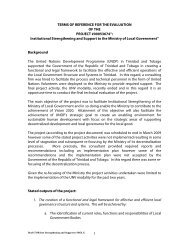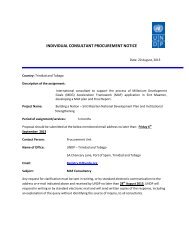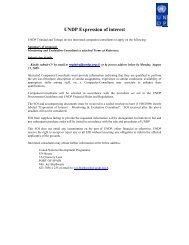Curaçao & Sint Maarten - UNDP Trinidad and Tobago
Curaçao & Sint Maarten - UNDP Trinidad and Tobago
Curaçao & Sint Maarten - UNDP Trinidad and Tobago
Create successful ePaper yourself
Turn your PDF publications into a flip-book with our unique Google optimized e-Paper software.
Target 7.3 Improvement in the lives of persons living in poor communities<br />
There are no large slum areas on the isl<strong>and</strong>s of <strong>Curaçao</strong> <strong>and</strong> <strong>Sint</strong> <strong>Maarten</strong>, though there are smaller areas on the<br />
isl<strong>and</strong>s of <strong>Curaçao</strong> <strong>and</strong> <strong>Sint</strong> <strong>Maarten</strong> with a relatively high percentage of inadequate housing. The highest percentage<br />
of poor housing was registered during the census of 2001 in <strong>Sint</strong> <strong>Maarten</strong>. In that year, 90% of the occupied <strong>and</strong><br />
unoccupied houses in <strong>Curaçao</strong> were found adequate <strong>and</strong> for <strong>Sint</strong> <strong>Maarten</strong> this was 83%.<br />
Table 7.5: Living accommodations by quality, in <strong>Curaçao</strong> <strong>and</strong> <strong>Sint</strong> <strong>Maarten</strong> in 2001<br />
<strong>Curaçao</strong> <strong>Sint</strong> <strong>Maarten</strong><br />
Quality of the accommodation occupied unoccupied occupied unoccupied<br />
Adequate 40348 3935 9905 680<br />
Inadequate 1853 850 1314 168<br />
Very inadequate 457 710 272 94<br />
Source: CBS, National Census 2001<br />
Unknown 503 389 236 95<br />
Total 43161 5884 11727 1037<br />
Target 7.4 Awareness of economic, social <strong>and</strong> environmental threats<br />
for at least 5 years<br />
<strong>Curaçao</strong> <strong>and</strong> <strong>Sint</strong> <strong>Maarten</strong> have nature conservation legislation which is consistent with CITES <strong>and</strong> the SPAW<br />
protocol. Although <strong>Curaçao</strong> <strong>and</strong> <strong>Sint</strong> <strong>Maarten</strong> have a nature policy, they do not have a nature conservation plan<br />
<strong>and</strong> the implementation, the responsibility of the local governments, has been poor. The former Netherl<strong>and</strong>s<br />
Antilles government required each isl<strong>and</strong> to have a nature conservation plan but there was no compliance with<br />
this requirement. As indicated from the report ‘Review Status of Implementation of the Convention on Biodiversity<br />
of Dutch Caribbean’ in July 2010, <strong>Curaçao</strong> <strong>and</strong> <strong>Sint</strong> <strong>Maarten</strong> now have to draft their own nature conservation <strong>and</strong><br />
zoning legislation <strong>and</strong> will be responsible for the implementation, monitoring <strong>and</strong> reporting.<br />
Natural disasters exert an enormous toll on development. In doing so, they pose a significant threat to prospects<br />
for alleviating poverty by 2015. Globally, annual economic losses associated with such disasters averaged US$75.5<br />
billion in the 1960s, US$138.4 billion in the 1970s, US$213.9 billion in the 1980s <strong>and</strong> US$659.9 billion in the 1990s.<br />
Although the majority of these losses have been concentrated in the developing world, they have failed to adequately<br />
capture the impact of the disaster on the poor who often bear the greatest cost in terms of lives <strong>and</strong> livelihoods, <strong>and</strong><br />
rebuilding their shattered communities <strong>and</strong> infrastructure. While 85 per cent of the people exposed to earthquakes,<br />
tropical cyclones, floods <strong>and</strong> droughts live in countries having either medium to low human development, recent<br />
experience in Curacao <strong>and</strong> <strong>Sint</strong> <strong>Maarten</strong> show that SIDS is also vulnerable to these impacts.<br />
The Fourth Asian Ministerial Conference on Disaster Risk Reduction that was held in Incheon (Republic of<br />
Korea) in October 2010 linked disaster risk reduction to the need for green growth. Green growth is indeed also<br />
gradually getting on the agenda in Curacao. The Ministry of General Affairs <strong>and</strong> Planning <strong>and</strong> Services are leading<br />
on the preparations for a national governing program which will include components to address on sustainable<br />
development issues in (poverty alleviation, progress on MDGs, increased forest cover; climate change effects; Green<br />
House Gas emissions) etc,. Such programming should use new, modified sustainable development indicators to<br />
inform analysis <strong>and</strong> policy development, with special focus on climate change relevant aspects. Assessment of cost<br />
<strong>and</strong> benefits of alternative energy sources, <strong>and</strong> on the implications of climate change for large scale infrastructure<br />
development will also be necessary.<br />
First National Report | <strong>Curaçao</strong> <strong>and</strong> <strong>Sint</strong> <strong>Maarten</strong> Millennium Development Goals | 2011 Report<br />
97





